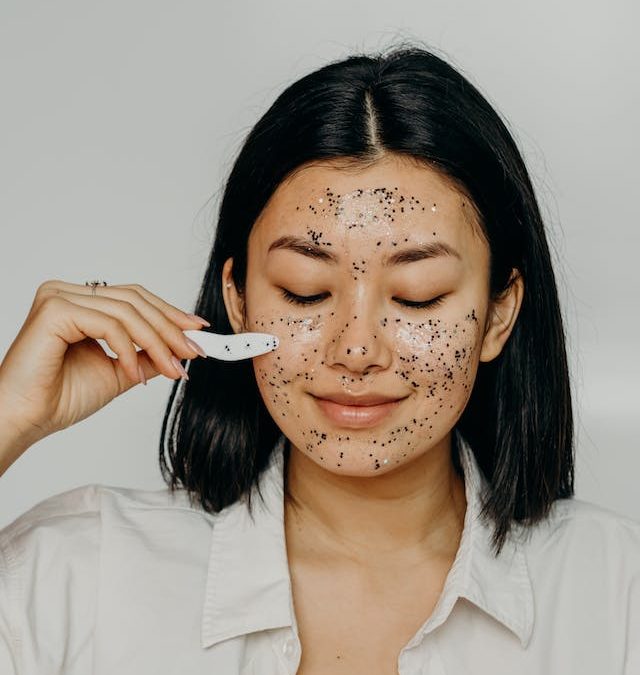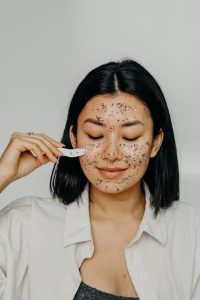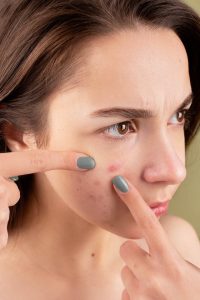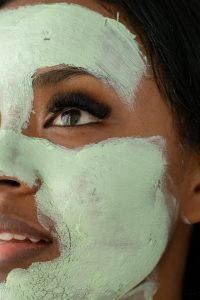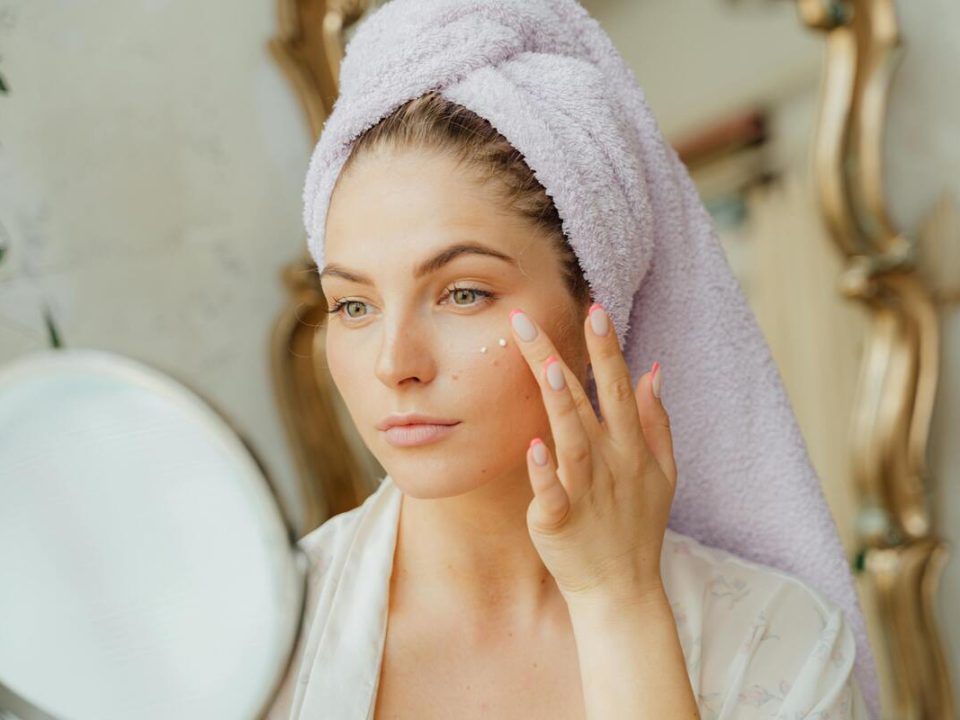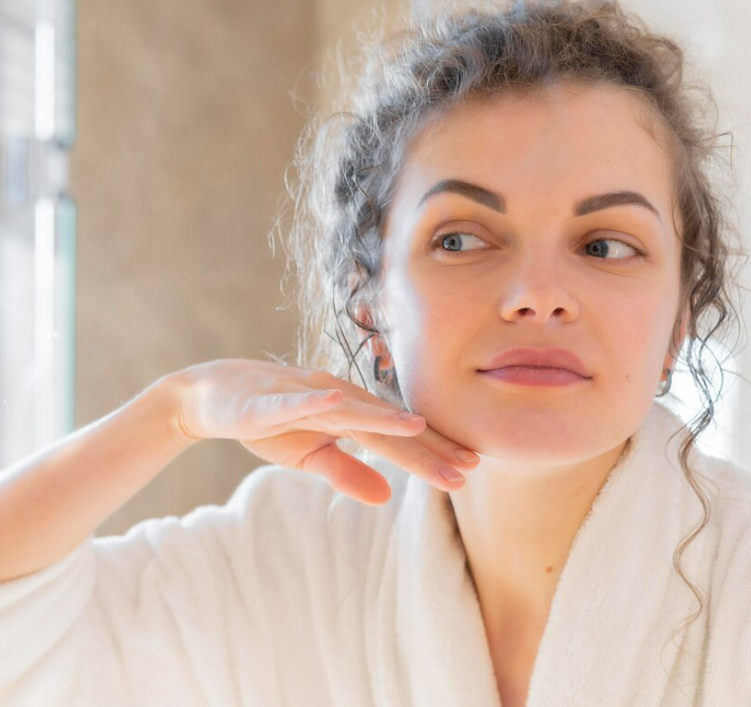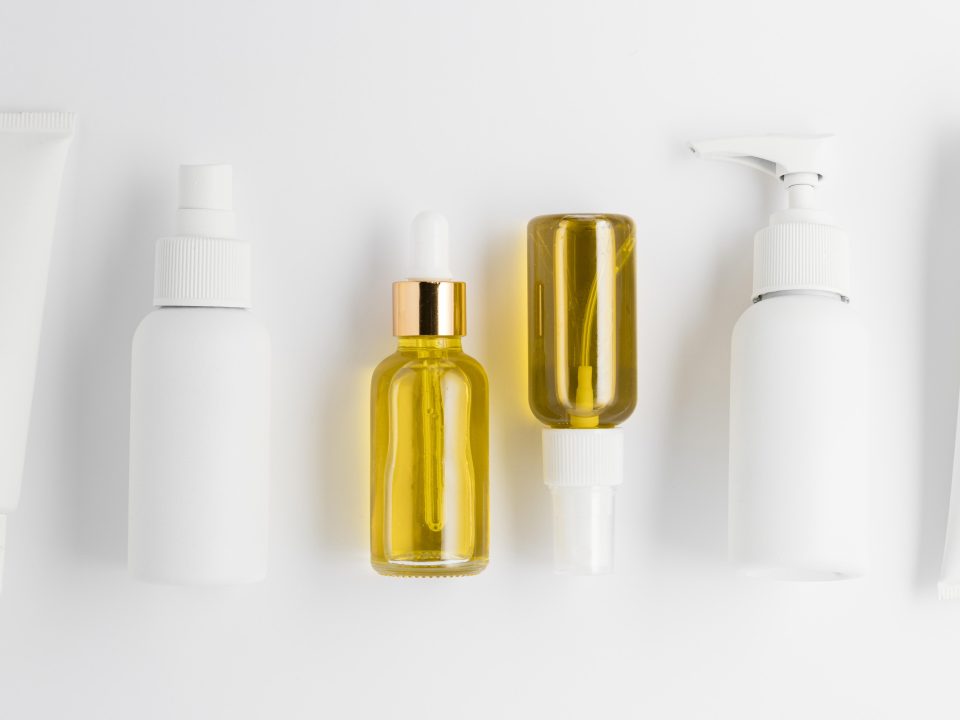
How Often Should One Use An Under-Eye Serum/Cream?
November 9, 2023
Where Do Dead Skin Cells Go When You Moisturize?
November 9, 2023The human skin, a marvel of biological engineering, is our body’s largest and most visible organ. It’s a dynamic, living barrier that continuously renews itself, shedding its outermost layer in a process known as desquamation. This natural cycle involves the formation of new skin cells in the deepest layer of the epidermis, which then gradually migrate upwards, replacing the older cells that die and flake off. It’s a finely-tuned mechanism ensuring our skin remains resilient and healthy.
But what happens when we intervene in this process? Is it beneficial or detrimental to actively remove dead skin cells? Understanding the balance between aiding the natural process and causing harm is essential for maintaining optimal skin health.
The Skin’s Natural Process
Understanding the skin’s life cycle is crucial to appreciating the importance and implications of its natural shedding process. The skin operates in a dynamic, ever-evolving cycle that commences deep within the epidermis, the skin’s outermost layer. New skin cells, born in the basal layer of the epidermis, embark on a journey upwards, transforming as they go. This journey, which takes approximately 28 days in a young adult but tends to slow down with age, involves the cells maturing, dying, and eventually becoming part of the stratum corneum, the outermost layer of dead skin cells.
This natural shedding process, or desquamation, is more than just a mechanism for discarding old cells; it plays a pivotal role in the health and functionality of our skin. As these cells migrate and transform, they develop a cornified envelope – a protective layer that shields our body against environmental hazards like pathogens, UV radiation, and harmful chemicals. This intricate process ensures that the skin maintains its role as a formidable barrier, all while keeping itself fresh and rejuvenated.
But why does our skin shed these cells? The shedding is a form of biological maintenance and rejuvenation. It allows the skin to dispose of cells that have been damaged by external factors like sun exposure or pollution, thereby preventing potential buildup of harmful agents or irritants. Moreover, this constant renewal process helps in maintaining skin hydration, as new cells are more capable of holding moisture than older, dead cells.
The role of these dead skin cells, then, is twofold. While they are a key component in protecting the body against external elements, their accumulation can lead to issues like dullness, rough texture, and in some cases, acne due to clogged pores. The balance between retaining enough cells for protection and shedding excess cells to maintain healthy, functional skin is a fine one, and understanding this balance is crucial in any skincare routine.
Reasons for Manual Dead Skin Removal
Manual dead skin removal, commonly known as exfoliation, is a popular skincare practice with several motivations driving its widespread appeal.
-
Cosmetic Appearance and Smooth Texture: One of the primary reasons for exfoliating is to enhance the skin’s appearance. Over time, the accumulation of dead skin cells can lead to a dull, rough, and uneven texture. Manual removal of these cells reveals the fresher, smoother skin underneath, immediately improving the skin’s appearance. This rejuvenation not only imparts a healthy, radiant glow but also evens out skin tone, helping to reduce the appearance of minor imperfections and signs of aging.
-
Prevention of Pore Blockage and Acne: Dead skin cells, if not regularly removed, can mix with sebum (the skin’s natural oil) and clog pores, leading to blackheads, whiteheads, and acne. Exfoliation is particularly beneficial for those with oily or acne-prone skin, as it helps in keeping the pores clear and reduces the likelihood of breakouts. By removing the outer layer of dead skin, exfoliation also aids in the prevention of pore enlargement, maintaining a smoother and clearer skin surface.
-
Enhancing the Effectiveness of Skincare Products: Another significant benefit of removing dead skin is improved absorption and efficacy of skincare products. Layers of dead cells can act as a barrier, preventing moisturizers, serums, and other skincare treatments from penetrating deeply into the skin. By exfoliating, these products can reach deeper layers of the skin, thereby working more effectively and delivering better results.
-
Cultural and Historical Practices in Skin Exfoliation: Exfoliation has deep roots in various cultures and historical practices. For centuries, different civilizations have incorporated various forms of skin exfoliation into their beauty and hygiene routines, recognizing its benefits for skin health and appearance. From the ancient Egyptians using abrasive tapes to the Turkish Hammam baths and the traditional Korean seshin, these practices highlight the long-standing recognition of the importance of skin exfoliation in maintaining a healthy, vibrant complexion.
In essence, manual dead skin removal is more than just a cosmetic practice; it is a beneficial skincare step rooted in history, contributing to both the aesthetic and health aspects of skin maintenance.
Methods of Removing Dead Skin
The methods of removing dead skin vary widely, each with its own set of benefits and considerations. From at-home scrubs to professional treatments, the options are extensive.
-
Mechanical Methods – Scrubs, Loofahs, Brushes: Mechanical or physical exfoliation involves using a tool or scrub to manually remove dead skin cells. Common methods include using scrubs made with granular substances like sugar, salt, or microbeads, and tools like loofahs, sponges, or brushes. These methods physically slough off dead skin cells, revealing smoother skin underneath. While they can be effective for many, especially those with resilient skin, they can also be harsh and potentially damaging, especially for sensitive or acne-prone skin types. It’s important to use gentle motions and avoid over-exfoliating to prevent skin irritation.
-
Chemical Methods – AHAs, BHAs, Enzymes: Chemical exfoliants use acids or enzymes to dissolve and loosen the bonds between dead skin cells, allowing them to be easily washed away. Alpha hydroxy acids (AHAs) like glycolic and lactic acid are water-soluble and effective for surface exfoliation, making them suitable for dry or sun-damaged skin. Beta hydroxy acids (BHAs) like salicylic acid are oil-soluble, penetrating deeper into the pores, making them ideal for oily and acne-prone skin. Enzymatic exfoliants, derived from fruits like papaya and pineapple, offer a gentler approach, suitable for sensitive skin. The key is to start with a low concentration and gradually increase to prevent irritation.
-
Professional Treatments – Microdermabrasion, Chemical Peels: For more intensive exfoliation, professional treatments such as microdermabrasion and chemical peels can be highly effective. Microdermabrasion involves using a device to exfoliate and remove the superficial layer of dry, dead skin cells. Chemical peels use stronger acid solutions for deeper exfoliation. These treatments are typically more controlled and can be tailored to individual skin types and concerns but often require downtime for recovery.
-
Natural and Home Remedies: Natural exfoliants like oatmeal, coffee grounds, or baking soda mixed with a liquid are popular for those who prefer a more DIY approach. These can be gentler and more environmentally friendly, though their effectiveness varies and they may not be suitable for all skin types.
-
Comparison of Efficacy and Suitability for Different Skin Types: The efficacy of each method depends on skin type and condition. For example, mechanical methods can be effective for those with thicker, oilier skin but may be too abrasive for sensitive skin. Chemical exfoliants are generally more uniform and controlled, suitable for a wider range of skin types, including sensitive skin when used correctly. Professional treatments offer targeted, potent results but require careful consideration and often a skin specialist’s guidance. Natural remedies are milder and can be suitable for those with sensitivities or preferences for natural ingredients, though they may not offer the same level of efficacy as formulated products. Ultimately, the best approach depends on individual skin type, concerns, and personal preference.
Potential Risks and Drawbacks of Exfoliation
While exfoliation can yield numerous benefits for skin health and appearance, it’s not without potential risks and drawbacks, particularly if done improperly or excessively.
Skin Irritation and Damage: One of the most immediate risks of exfoliation, especially with mechanical methods or harsh chemicals, is skin irritation and damage. This can manifest as redness, burning, itching, or increased sensitivity. Aggressive exfoliation can cause micro-tears in the skin, leading to inflammation and even infection. It’s crucial to be gentle and use suitable products to minimize these risks.
Over-exfoliation Symptoms and Consequences: Over-exfoliation refers to the removal of too many skin cells, which can strip away the skin’s protective barrier. Symptoms include tightness, dry patches, peeling, increased oiliness, and breakouts. These issues arise because the skin tries to compensate for the loss of its protective layer. Prolonged over-exfoliation can lead to chronic skin issues, including persistent dryness or oiliness, heightened sensitivity, and susceptibility to acne.
Disruption of the Skin Barrier and pH Balance: The skin’s barrier function and its acidic pH are vital for maintaining skin health. Excessive exfoliation can disrupt the skin’s pH balance, weakening its ability to protect against harmful microbes and environmental stressors. This disruption can lead to increased dryness, irritation, and a higher likelihood of skin conditions like eczema or rosacea flaring up.
Increased Sensitivity to Sunlight and Products: Exfoliated skin is more susceptible to UV damage due to the removal of the outermost layer. This heightened sensitivity necessitates diligent use of sunscreen to prevent sunburn and photoaging. Similarly, freshly exfoliated skin may react more intensely to certain skincare products, especially those with active ingredients, leading to irritation.
Special Considerations for Sensitive or Problematic Skin: Individuals with sensitive, acne-prone, or problem skin need to be particularly cautious with exfoliation. Harsh exfoliants can aggravate these conditions, leading to worsening of symptoms. It’s recommended to use gentle, non-abrasive methods, and to always conduct a patch test before trying a new exfoliation product or method.
While exfoliation can be beneficial, it’s important to approach it with caution, understanding your skin’s needs and limits, to avoid these potential risks and drawbacks.
Best Practices for Safe Exfoliation
Exfoliation can be a beneficial part of a skincare routine when done correctly. Here are some best practices to ensure safe and effective exfoliation:
Understanding Your Skin Type and Needs: The first step is to understand your skin type – whether it’s dry, oily, combination, sensitive, or normal. Different skin types have different needs and tolerance levels for exfoliation. For example, sensitive or dry skin may require a gentler approach, while oily skin might tolerate more frequent exfoliation. Understanding your skin’s unique characteristics will help in choosing the right exfoliation method and products.
Frequency and Intensity of Exfoliation: There’s no one-size-fits-all answer for how often you should exfoliate, as it depends on your skin type and the exfoliation method. A general guideline is to start with once a week and observe how your skin reacts, gradually increasing frequency if needed. It’s crucial to avoid over-exfoliation, as it can lead to skin damage and irritation. The intensity of the exfoliation should also be considered – gentler exfoliants can be used more frequently, while stronger ones should be used less often.
Importance of Post-Exfoliation Skincare – Moisturizing and Sun Protection: After exfoliation, the skin can be more vulnerable and sensitive. It’s essential to follow up with a good moisturizer to replenish hydration and restore the skin’s barrier. Also, since exfoliated skin is more prone to sun damage, applying a broad-spectrum sunscreen is vital to protect against UV rays and prevent photoaging.
Signs to Watch for Over-Exfoliation: Be vigilant for signs of over-exfoliation, such as redness, irritation, dryness, increased sensitivity, or breakouts. If you notice any of these signs, give your skin a break from exfoliation and focus on gentle, restorative skincare.
When to Consult a Dermatologist: If you have specific skin concerns, such as severe acne, rosacea, or eczema, or if you’re unsure about the best exfoliation practices for your skin, consulting a dermatologist is advisable. They can provide tailored advice and recommend products and treatments that are safe and effective for your skin condition.
By following these guidelines, you can ensure that exfoliation enhances your skin’s health and appearance, without causing harm or irritation.
Check Out Our Skincare Products at Skin Beauty Solutions
Understanding your skin type and needs, choosing the right method and frequency of exfoliation, and following with proper post-exfoliation care are crucial for maintaining skin health. It’s vital to listen to your skin’s responses and recognize signs of over-exfoliation or irritation. Don’t hesitate to consult a dermatologist, especially for specific concerns or conditions.
While it’s tempting to continuously seek smoother, clearer skin, it’s essential to respect the skin’s natural processes. Overdoing exfoliation can do more harm than good, so it’s important to strike a balance.
At Skin Beauty Solutions, we understand the intricacies of skin care and are committed to providing high-quality products that cater to diverse skin needs. Whether you’re looking for anti-aging treatments, skin-lightening products, acne prevention serums, or moisturizers, our range is designed to offer effective solutions. We prioritize bioactive natural ingredients, combining antioxidants, lipids, and vitamins to address your skin concerns with care and precision.
By adopting a thoughtful and informed approach to skincare, you can maintain healthy, vibrant skin that reflects your inner well-being. Remember, every skin journey is unique, and at Skin Beauty Solutions, we’re here to support you every step of the way.

